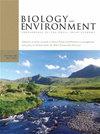The Gunnera manicata: Nostoc Symbiosis: Is the Red Stipulate Tissue Symbiogenetic?
IF 0.6
4区 环境科学与生态学
Q4 ENVIRONMENTAL SCIENCES
Biology and Environment-Proceedings of the Royal Irish Academy
Pub Date : 2022-01-01
DOI:10.3318/BIOE.2002.102.1.45
引用次数: 7
Abstract
All species of the angiosperm genus Gunnera form an intracellular symbiosis with hormogonium-pro ducing strains of Nostoc cyanobacteria. Gunnera is the only angiosperm genus known to enter symbi otic associations with cyanobacteria capable of fixing nitrogen. Unlike most symbioses, the Gun nera cyanobacterial associations are intracellular (Bergman et al. 1992). Of the 45 species of Gun nera, the smaller species are typically aquatic, whereas the larger species tend to occupy high-al titude cliff faces and stream banks (Osborne et al. 1991). Free-living Nostoc cyanobacteria live in the moist soils of the Gunnera habitats. They form long photosynthetic filaments that bear nitrogen-fixing heterocysts interspersed among the cells. The port of entry for Nostoc into Gunnera is via the unique glands present at the base of each leaf petiole in all Gunnera species (Bergman et al. 1992). Aseriate photoautotrophic Nostoc filaments that bear heterocysts are induced to differentiate into motile, heterocyst-free hormogonia filaments by various compounds present in the mucus secreted by the Gunnera gland tissue. The Nostoc hormogonia respond to a chemical signal and glide down the extracellular channels of the Gunnera gland, against the direction of both gland mucilage production and their usual positive phototaxis, to enter the Gunnera cortical cells. In the dark, Nostoc cells become heterotrophic, intracellular sym bionts. They rely on Gunnera for photosynthates, and the fixed nitrogen from their now re-differen tiated heterocysts is assimilated by the plant tissue. 'Whereas all Gunnera species, small and large, bear Nostoc-infecting glands, only the larger Gunnera species possess clusters of large red stipules that abundantly surround glands at the base of each leaf petiole (P1. IA-C). They are more distinc tively distributed, pigmented, mucous-laden and conspicuous than other plant stipules. We concur that the term 'stipule' (rather than bract or leaf bud) is the most accurate one for these structures. The focus of Gunnera-Nostoc symbiosis research is on the process by which Nostoc infects the Gunnera gland, not on the presence of Nostoc on the plant tissue surrounding the gland. Such an emphasis causes the stipulate tissue on the larger Gunnera species to be ignored in the literature, as it is often removed from the plant by researchers who have studied the gland tissue buried beneath.摩尼罗:怀旧共生:红色规定组织是共生的吗?
所有种类的被子植物属Gunnera形成一种细胞内的共生与产激素菌株蓝藻蓝藻。Gunnera是已知的唯一与能够固定氮的蓝藻共生的被子植物属。与大多数共生关系不同,gunnera蓝藻是细胞内的(Bergman et al. 1992)。在Gun属的45种中,较小的种类通常是水生的,而较大的种类往往占据高海拔的悬崖表面和河岸(Osborne et al. 1991)。自由生活的蓝藻蓝藻生活在Gunnera栖息地的潮湿土壤中。它们形成长长的光合细丝,在细胞间散布着固氮杂囊。Nostoc进入Gunnera的入口是通过所有Gunnera物种中每个叶柄基部的独特腺体(Bergman et al. 1992)。受Gunnera腺组织分泌的粘液中存在的各种化合物的诱导,携带异囊的无菌化光自养褐藻细丝分化为可运动的、无异囊的同源细丝。褐藻对化学信号作出反应,沿着Gunnera腺体的细胞外通道,与腺体粘液分泌和通常的正向趋光性方向相反,进入Gunnera皮质细胞。在黑暗中,Nostoc细胞变成异养的细胞内共生生物。它们依靠Gunnera进行光合作用,来自它们现在重新分化的异囊的固定氮被植物组织吸收。然而所有的冈属植物,无论大小,都有感染nostoc的腺体,只有较大的冈属植物在每个叶柄基部的腺体周围有大量的红色大托叶(P1。IA-C)。它们比其他植物的托叶更明显地分布,有色素,有粘液和明显。我们同意术语“托叶”(而不是苞片或叶芽)是这些结构最准确的一个。Gunnera-Nostoc共生研究的重点是Nostoc感染Gunnera腺体的过程,而不是Nostoc在腺体周围的植物组织上的存在。这样的强调导致较大的Gunnera物种的规定组织在文献中被忽略,因为它经常被研究埋在下面的腺体组织的研究人员从植物中移除。
本文章由计算机程序翻译,如有差异,请以英文原文为准。
求助全文
约1分钟内获得全文
求助全文
来源期刊
CiteScore
1.10
自引率
0.00%
发文量
6
审稿时长
>36 weeks
期刊介绍:
The journal aims to offer a broad coverage of the subject area, including the following:
- biology and ecology of the Irish flora and fauna
- microbial ecology
- animal, plant and environmental physiology
- global change
- palaeoecology and palaeoclimatology
- population biology; conservation of genetic resources
- pollution and environmental quality; ecotoxicology
- environmental management
- hydrology
- land use, agriculture, soils and environment.
Submissions on other relevant topics are also welcome, and papers of a cross-disciplinary nature are particularly encouraged.

 求助内容:
求助内容: 应助结果提醒方式:
应助结果提醒方式:


